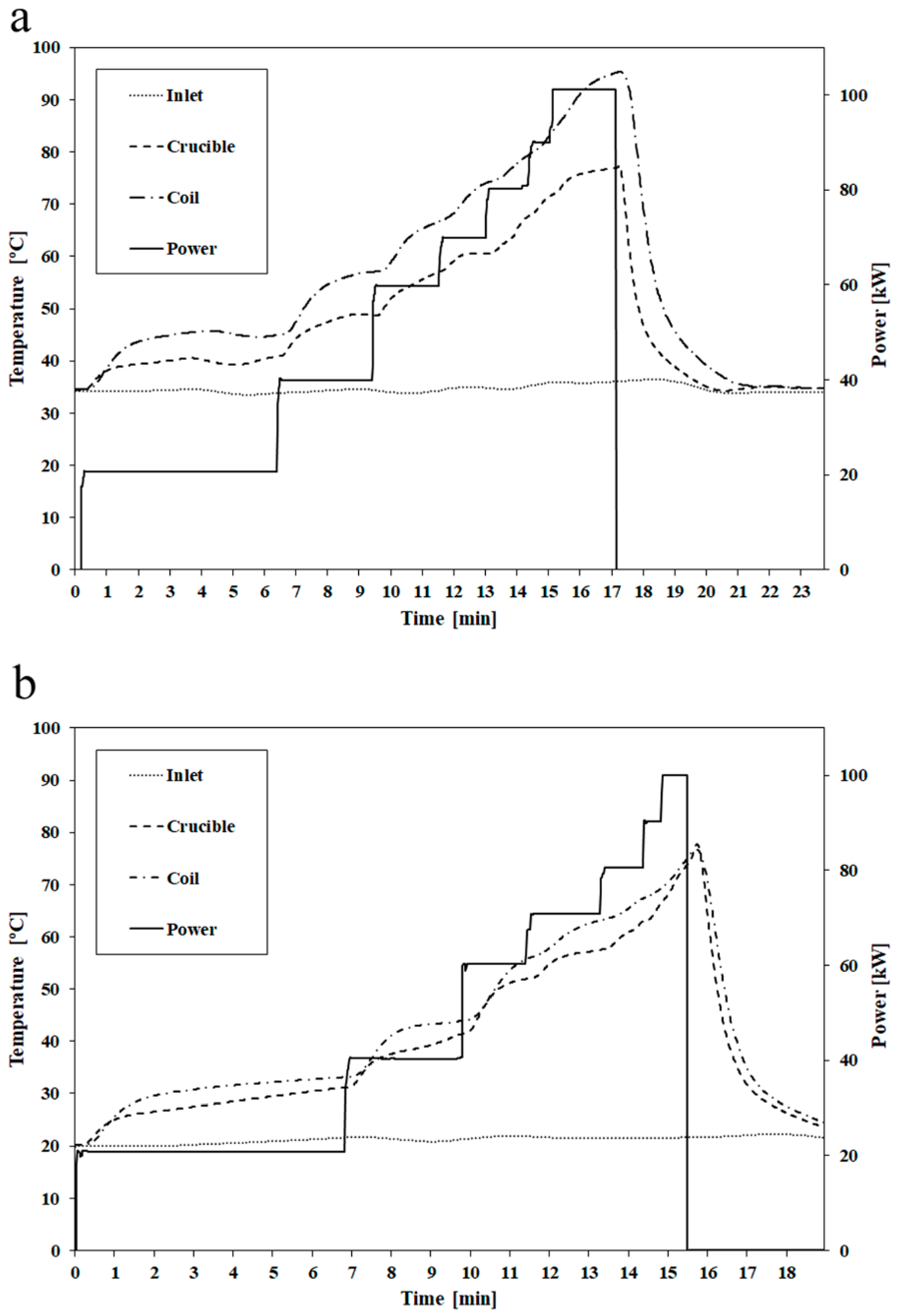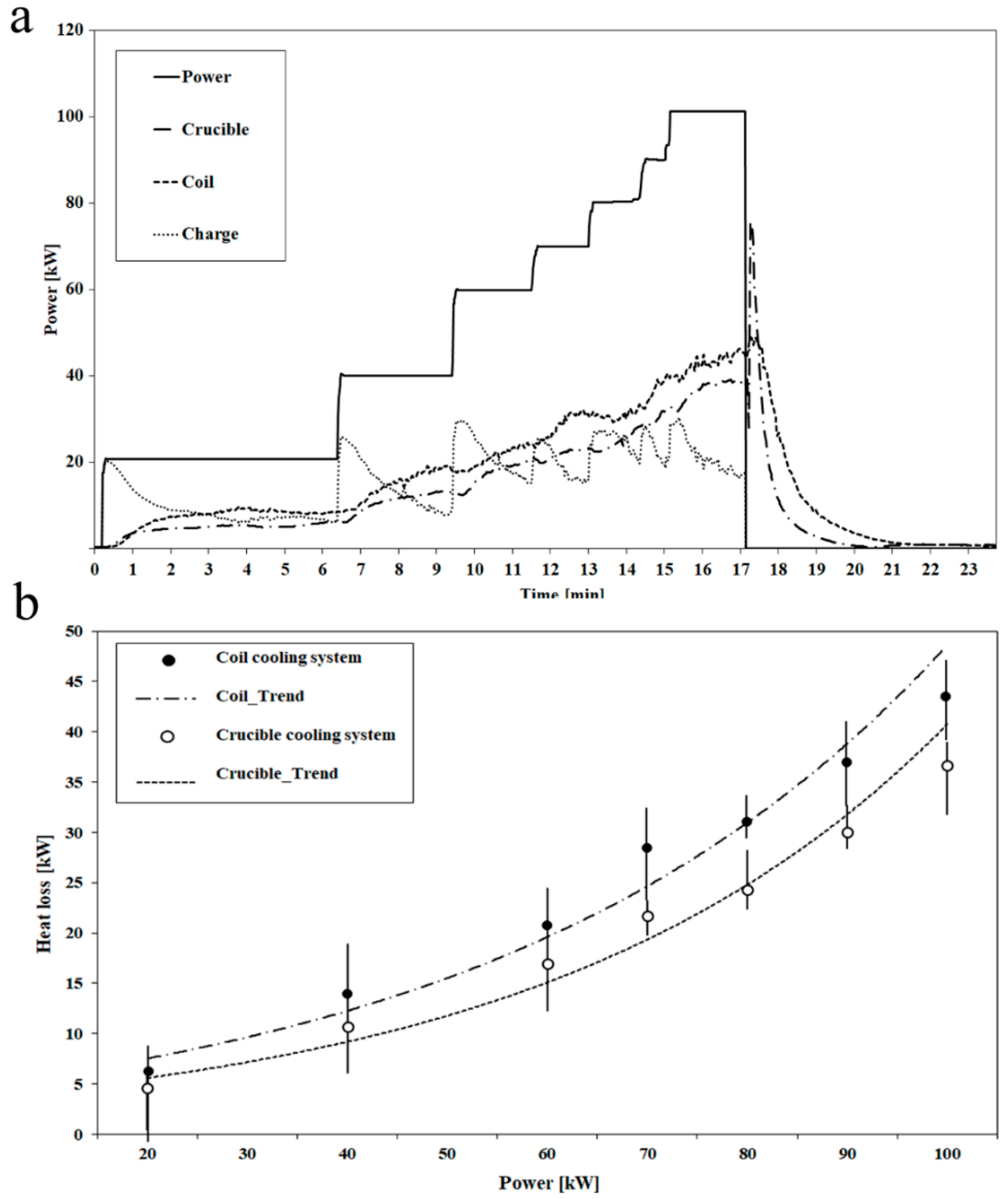Induction Skull Melting of Ti-6Al-4V: Process Control and Efficiency Optimization
Abstract
:1. Introduction
1.1. ISM Technology
1.2. Research Objective and Plan
2. Materials and Methods
2.1. Calorimetric Balance Calculation
2.2. ISM Facility
2.3. Material Selection
2.4. Process Parameters
2.5. Melting Procedure
3. Results
3.1. Cooling System
3.2. Power Distribution
3.3. Process Efficiency
3.4. Power Profile and Charge Temperature
4. Discussion
4.1. Cooling Temperature and Power Distribution
4.2. Charge Temperature
4.3. Process Parameter Evolution
5. Conclusions
Author Contributions
Funding
Acknowledgments
Conflicts of Interest
References
- Michaels, D. New materials for airplanes. Wall Street J. Eur. Ed. 2013, June, 17. [Google Scholar]
- Güther, V.; Allen, M.; Klose, J.; Clemens, H. Metallurgical processing of titanium aluminides on industrial scale. Intermetallics 2018, 103, 12–22. [Google Scholar] [CrossRef]
- Tetsui, T. Manufacturing technology for gamma-TiAl alloy in current and future applications. Rare Met. 2011, 30, 294–299. [Google Scholar] [CrossRef]
- Chamorro, X.; Herrero-Dorca, N.; Rodríguez, P.P.; Andrés, U.; Azpilgain, Z. α-case formation in Ti-6Al-4V investment casting using ZrSiO4 and Al2O3 moulds. J. Mater. Process. Technol. 2016, 243, 75–81. [Google Scholar] [CrossRef]
- Aguilara, J.; Schievenbuschb, A.; Kattlitzc, O. Qualification of a casting technology for production of titanium aluminide components for aero-engine applications. Adv. Mater. Res. 2011, 278, 563–568. [Google Scholar] [CrossRef]
- Sabbadini, S. Electron beam melting of second and third generation TiAl alloys. In Proceedings of the 5th International Workshop on Titanium Aluminides, Tokyo, Japan, 28 August–2 September 2016. [Google Scholar]
- Voisin, T.; Monchoux, J.P.; Hantcherli, M.; Mayer, S.; Clemens, H.; Couret, A. Microstructure and mechanical properties of a multi-phase β-solidifying TiAl alloy densified by spark plasma sintering. Acta Mater. 2014, 73, 107–115. [Google Scholar] [CrossRef]
- Baudana, G.; Biamino, S.; Klöden, B.; Kirchner, A.; Weißgärber, T.; Kieback, B.; Pavese, M.; Ugues, D.; Fino, P.; Badini, C. Electron beam melting of Ti-48Al-Nb-0.7Cr- 0.3Si: feasibility investigation. Intermetallics 2016, 73, 43–49. [Google Scholar] [CrossRef]
- Güther, V.; Keitel, H.; Klose, J.; Rothe, C.; Eulitz, I. Development of an industrial recycling technology for TiAl revert. In Proceedings of the 5th International Workshop on Titanium Aluminides, Tokyo, Japan, 28 August–2 September 2016. [Google Scholar]
- Kamyshnykova, K.; Lapin, J. Vacuum induction melting and solidification of TiAl-based alloy in graphite crucibles. Vacuum 2018, 154, 218–226. [Google Scholar] [CrossRef]
- Yang, J.; Wang, H.; Wu, Y.; Wang, X.; Hu, R. A combined electromagnetic levitation melting, counter gravity casting, and mold preheating furnace for producing TiAl alloy. Adv. Eng. Mater. 2017, 20, 1–7. [Google Scholar] [CrossRef]
- Harding, R.A.; Wickins, M. Temperature measurements during induction skull melting of titanium aluminide. Mater. Sci. Technol. 2003, 19, 1235–1246. [Google Scholar] [CrossRef]
- Xue, G.; Wang, T.; Su, Y.; Cai, S.; Xu, J.; Li, J.; Guo, J.; Li, T. Numerical simulation of thermal and flow fields in induction skull melting process. Rare Met. Mater. Eng. 2009, 38, 761–765. [Google Scholar]
- Umbrashko, A.; Baake, E.; Nacke, B.; Jakovics, A. Experimental investigations and numerical modelling of the melting process in the cold crucible. COMPEL - The Int. J. Comput. Math Electr. Electron. Eng. 2005, 24, 314–323. [Google Scholar] [CrossRef]
- Pericleous, K.; Bojarevics, V.; Djambazov, G.; Harding, R.A.; Wickins, M. Experimental and numerical study of the cold crucible melting process. Appl. Math. Modell. 2006, 30, 1262–1280. [Google Scholar] [CrossRef]
- Harding, R.A.; Wickins, M.; Li, Y.G. Progress towards the production of high quality γ-TiAl castings. In Proceedings of the 3rd International Symposium on Structural Intermetallics, Jackson Hole, WY, USA, 28 April–2 May 2002; pp. 181–189. [Google Scholar]
- Bojarevics, V.; Harding, R.A.; Pericleous, K.; Wickins, M. The development and experimental validation of a numerical model of an induction skull melting furnace. Metall. Mater. Trans. B 2004, 35, 785–803. [Google Scholar] [CrossRef]
- Gomes, F.; Puga, H.; Barbosa, J.; Ribeiro, C.S. Effect of melting pressure and superheating on chemical composition and contamination of yttria-coated ceramic crucible induction melted titanium alloys. J. Mater. Sci. 2011, 46, 4922–4936. [Google Scholar] [CrossRef]
- Haun, R.; Charles, M.; Lampson, R.; Meese, P.; Nemkov, V.S.; Goldstein, R.; Kreter, K. Recent Design and Operational Developments of Cold Wall Induction Melting Crucibles for Reactive Metals Processing. Available online: https://fluxtrol.com/recent-design-and-operational-development-of-cold-wall-induction-melting-crucibles?utm_source=September&utm_medium=email&utm_campaign=FluxtrolEmail;2017 (accessed on 19 October 2017).
- Golak, S.; Przyłucki, R.; Smołka, J.; Bulinski, P.; Cieplinski, P. Influence of a cold crucible geometry parameters on electrical efficiency. Int. J. Appl. Electromagnet Mech. 2018, 56, 165–172. [Google Scholar] [CrossRef]
- Dumont, M.; Ernst, R.; Garnier, C.; Petitpas, P. Recent progresses in optimizing inductive cold crucible processes. In Proceedings of the 6th International Conference on Electromagnetic Processing of Materials, Dresden, Germany, 19–23 October 2009. [Google Scholar]
- Bojarevics, V.; Pericleous, K. Modeling induction skull melting design modifications. J. Mater. Sci. 2004, 39, 7245–7251. [Google Scholar] [CrossRef]
- Spitans, S.; Jakovics, A.; Baake, E.; Nacke, B. Numerical modelling of free surface dynamics of melt in induction crucible furnace. Magnetohydrodynamics 2010, 46, 317–328. [Google Scholar]
- Quintana, I. Numerical Modelling of Cold Crucible Induction Melting (Ccim) Process and Fabrication of High Value Added Components of Titanium and Its Alloys. Ph.D. Thesis, Mondragon Unibertsitatea, Guipuzkoa, Spain, 2013. [Google Scholar]
- Nemkov, V.; Goldstein, R.; Kreter, K.; Jackowski, J. Modeling and Optimization of Cold Crucible Furnaces for Melting Metals. In Proceedings of the International Symposium Heating by Electromagnetic Sources 2013, Padua, Italy, 21–24 May 2013. [Google Scholar]
- Bulinski, P.; Smolka, J.; Golak, S.; Przylucki, R.; Palacz, M.; Siwiec, G.; Melka, B.; Blacha, L. Numerical modelling of multiphase flow and heat transfer within an induction skull melting furnace. Int. J. Heat Mass Transf. 2018, 126, 980–992. [Google Scholar] [CrossRef]
- Ruirun, C.; Jieren, Y.; Hongsheng, D.; Feng, H.; Yanqing, S.; Jingjie, G.; Hengzhi, F. Effect of power parameter and induction coil on magnetic field in cold crucible during continuous melting and directional solidification. China Foundry 2012, 1, 15–19. [Google Scholar]
- Yang, J.; Wang, H.; Wu, Y.; Zhang, K.; Wang, X.; Hu, R. Numerical calculation and experimental evaluation of counter-gravity investment casting of Ti-48Al-2Cr-2Nb alloy. Int. J. Adv. Manuf. Technol. 2018. [Google Scholar] [CrossRef]
- Fu, P.X.; Kang, X.H. Centrifugal casting of TiAl exhaust valves. Intermetallics 2008, 16, 130–138. [Google Scholar] [CrossRef]
- Harding, R.A. Recent developments in the induction skull melting and investment casting of titanium aluminides. Kovove Mater. 2004, 42, 225–241. [Google Scholar]
- Oliveira, P.C.G.; Adabo, G.L.; Ribeiro, R.F.; Rocha, S.S. The effect of mold temperature on castability of CP Ti and Ti-6Al-4V castings into phosphate bonded investment materials. Dental Mater. 2006, 22, 1098–1102. [Google Scholar] [CrossRef] [PubMed]







| Charge diameter | 60 | [mm] |
| Charge height | 80 | [mm] |
| Charge weight | 1000 | [gr] |
| Tsolidus | 1604 | [°C] |
| Tliquidus | 1660 | [°C] |
| β-transus | 980 | [°C] |
| Parameter | First Melt | Second Melt | Units |
|---|---|---|---|
| Chiller threshold | 33 | 20 | [°C] |
| Crucible water flow | 13 | 10 | [liters·min−1] |
| Coil water flow | 11 | 8 | [liters·min−1] |
| Argon pressure | 100 | 100 | [mbar] |
© 2019 by the authors. Licensee MDPI, Basel, Switzerland. This article is an open access article distributed under the terms and conditions of the Creative Commons Attribution (CC BY) license (http://creativecommons.org/licenses/by/4.0/).
Share and Cite
Chamorro, X.; Herrero-Dorca, N.; Bernal, D.; Hurtado, I. Induction Skull Melting of Ti-6Al-4V: Process Control and Efficiency Optimization. Metals 2019, 9, 539. https://doi.org/10.3390/met9050539
Chamorro X, Herrero-Dorca N, Bernal D, Hurtado I. Induction Skull Melting of Ti-6Al-4V: Process Control and Efficiency Optimization. Metals. 2019; 9(5):539. https://doi.org/10.3390/met9050539
Chicago/Turabian StyleChamorro, Xabier, Nuria Herrero-Dorca, Daniel Bernal, and Iñaki Hurtado. 2019. "Induction Skull Melting of Ti-6Al-4V: Process Control and Efficiency Optimization" Metals 9, no. 5: 539. https://doi.org/10.3390/met9050539





